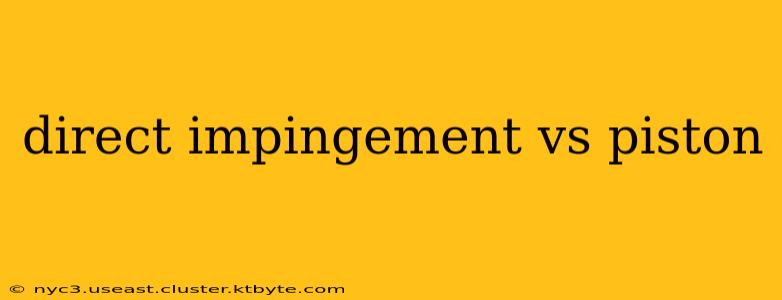Choosing the right gas operating system for a firearm is a crucial decision, impacting reliability, maintenance, and overall shooting experience. Two dominant systems stand out: direct impingement and piston. This detailed comparison will explore the intricacies of each, highlighting their strengths and weaknesses to help you make an informed choice.
Understanding Direct Impingement
Direct impingement (DI) systems utilize the expanding gases from the fired cartridge directly to cycle the action. These gases travel through a gas tube, located under the barrel, and impinge directly on the bolt carrier group (BCG). This simple design contributes to the system's lightweight nature and generally lower manufacturing cost.
Advantages of Direct Impingement:
- Lightweight and Simple: Fewer parts mean less weight and a simpler, more robust design, reducing potential points of failure.
- Cost-Effective: The straightforward design translates into lower manufacturing costs, making DI firearms generally more affordable.
- Accurate: The direct gas impulse contributes to a smoother recoil impulse in some shooters' experiences, potentially improving accuracy.
Disadvantages of Direct Impingement:
- Fouling: The hot gases and propellant residue directly impact the BCG, leading to significant carbon build-up. This requires more frequent cleaning to maintain reliable function.
- Increased Heat Transfer: The direct impingement system introduces considerable heat into the receiver, affecting shooter comfort and potentially degrading certain materials over time.
- Potential for Gas System Issues: Malfunctions can arise from gas system fouling or malfunctions. Gas tube issues are another potential cause of failure.
Delving into Piston Systems
Piston systems operate differently; the expanding gases push a piston, which in turn cycles the BCG. This indirect method keeps the propellant fouling and heat away from the receiver and BCG. There are two main types: short-stroke and long-stroke piston systems. Short-stroke pistons move a shorter distance, while long-stroke pistons cycle the entire length of the action.
Advantages of Piston Systems:
- Reduced Fouling: By keeping the gases and residue away from the BCG, piston systems result in cleaner operation and less frequent cleaning needs.
- Reduced Heat Transfer: The receiver remains cooler, enhancing shooter comfort and extending the lifespan of components.
- Increased Reliability in Adverse Conditions: The system’s greater resilience to fouling improves its reliability in harsh environments or with dirty ammunition.
Disadvantages of Piston Systems:
- Increased Complexity and Weight: The extra components, such as the piston and gas cylinder, add weight and complexity to the system.
- Higher Manufacturing Costs: The more complex design and additional parts lead to higher manufacturing costs and generally higher prices for firearms utilizing this system.
- Potentially Increased Recoil: Depending on the piston system design, some shooters perceive an increase in felt recoil compared to DI systems.
Direct Impingement vs. Piston: The Verdict
The "better" system depends on individual priorities. DI systems offer simplicity, affordability, and potentially smoother recoil, but suffer from increased fouling and heat. Piston systems boast improved reliability, cleanliness, and reduced heat transfer, but at the cost of increased complexity, weight, and price.
Consider these factors when making your choice:
- Intended Use: For frequent use in harsh conditions or with dirty ammunition, a piston system might be preferable. For recreational shooting with regular cleaning, a DI system might suffice.
- Budget: DI systems generally cost less, while piston systems tend to be more expensive.
- Maintenance Preference: If you prefer less frequent cleaning, a piston system offers significant advantages.
Ultimately, the best gas operating system is subjective and dependent upon the individual shooter’s needs and preferences. Understanding the strengths and weaknesses of each system allows for a more informed decision.

